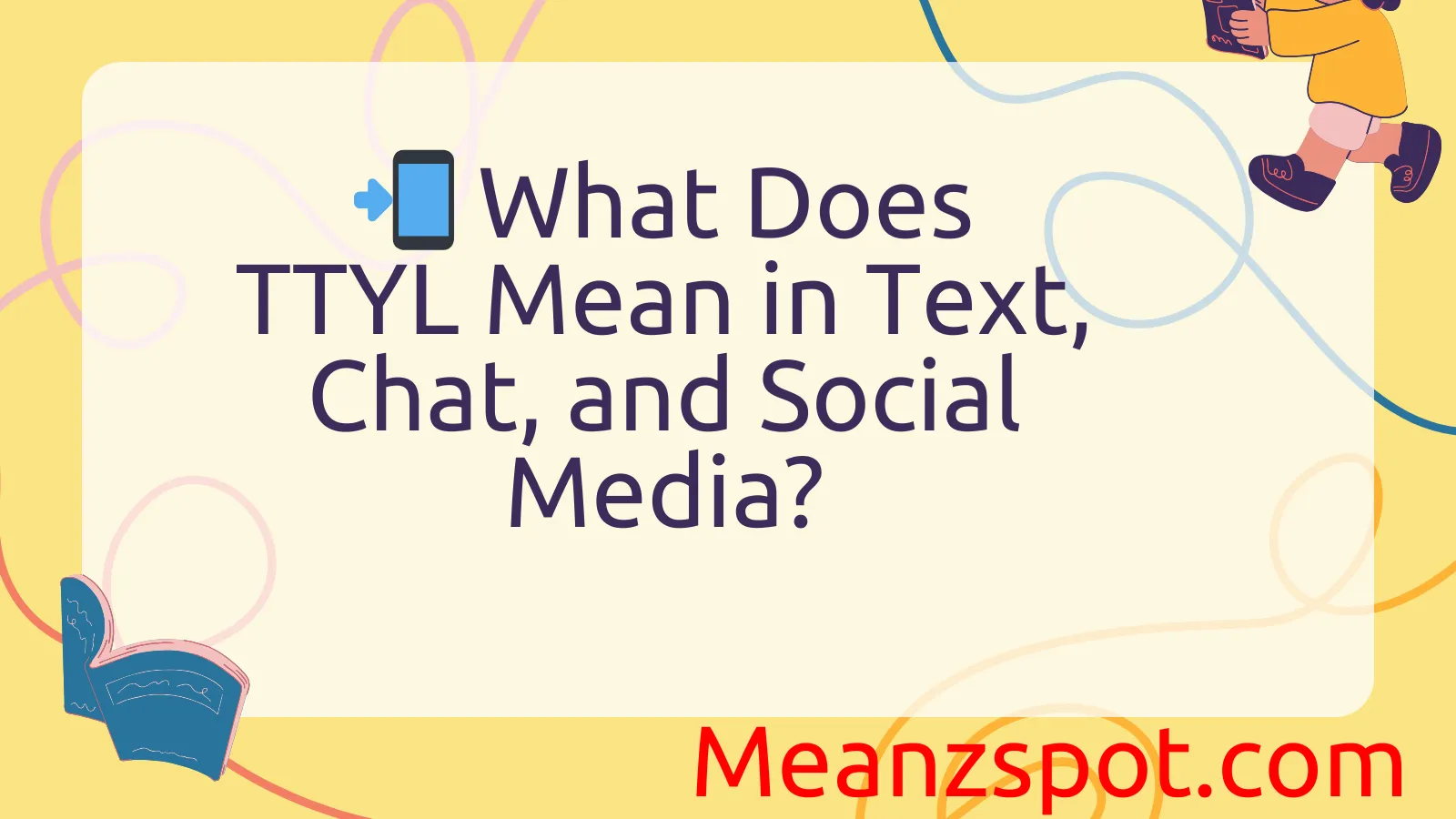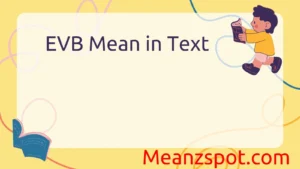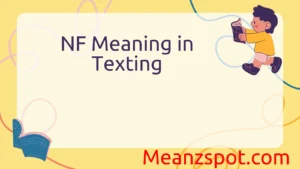Ever seen TTYL in text and wondered what it really means? 📲 Don’t worry—you’re not the only one! With new slang and abbreviations taking over chat and social media, it can feel tricky to keep up. TTYL is one of the most popular shorthand terms used in text messages, WhatsApp, Instagram, Snapchat, and TikTok, and it’s still widely used in 2025. 💬
In this guide, we’ll break down the true meaning of TTYL, where it’s commonly used, and how to reply naturally in conversations. From casual chats with friends to quick sign-offs in online communities, you’ll learn every context so you’ll never be left guessing again. ⚡
It’s time to stay updated, decode TTYL in texting, and level up your digital slang game! 🔥
Definitions & Meaning
“TTYL” is an acronym that stands for “Talk To You Later.” It is a casual phrase used to end a conversation, typically implying that the conversation will continue at another time. The tone is friendly and informal, making it common in personal messages between friends or acquaintances.
Example:
- Friend A: “Hey, I have to go now.”
- Friend B: “No problem, TTYL!”
In this context, “TTYL” is not a permanent goodbye. Instead, it’s similar to saying “catch you later” or “we’ll talk soon.” The phrase does not carry any strong emotional weight and is used in everyday casual interactions, especially in written formats like texting, instant messaging, and social media.
The expression is part of a broader category of text abbreviations used to simplify and speed up digital conversations. Alongside “TTYL,” people commonly use other shorthand phrases like “BRB” (Be Right Back), “GTG” (Got To Go), and “OMG” (Oh My God), which serve similar functions in conversation.
Origins & History
“TTYL” first gained popularity in the late 1990s and early 2000s, a time when texting and instant messaging services such as AOL Instant Messenger (AIM), MSN Messenger, and Yahoo! Messenger were widely used. At that time, character limits and slow typing speeds made abbreviated communication a necessity.
The term quickly became a staple of internet slang, especially among younger users who adopted acronyms as part of their digital language. The use of “TTYL” spread alongside the growth of mobile phones and SMS (Short Message Service), where brevity was key due to character restrictions.
By the early 2000s, “TTYL” had been cemented as a common phrase in online and text conversations. It even made its way into pop culture, appearing in song lyrics, television scripts, and teen novels. Its inclusion in urban dictionaries and even some formal dictionaries over time highlights how widely it has been accepted as a part of modern communication.
Though newer platforms and emoji culture have shifted how people communicate, “TTYL” still maintains its place as a familiar, recognizable phrase that continues to be used across generations.
Usage in Different Contexts
Social Media & Text Messaging
“TTYL” is primarily used in casual, real-time conversations, such as group chats or direct messages. It signals a pause in communication, not a permanent goodbye.
Example:
- “I’m about to head into a meeting. TTYL!”
On platforms like Twitter, Instagram, and Snapchat, where brevity and quick interactions are common, “TTYL” helps users wrap up conversations without sounding abrupt.
Professional Settings
In professional communication, “TTYL” is rarely appropriate. It can come off as too casual or even unprofessional. Business emails or workplace chats typically favor full phrases like “I’ll get back to you later” or “Let’s continue this later.”
Pop Culture References
The popularity of “TTYL” has led to its appearance in movies, TV shows, and even literature. The 2004 young adult novel ttyl by Lauren Myracle, written entirely in the format of instant messages, helped bring attention to how teens communicate digitally. Such portrayals have cemented “TTYL” as part of pop culture’s reflection of online communication trends.
Gaming and Online Communities
Gamers and users on platforms like Discord or Twitch also use “TTYL” when leaving voice chats or online lobbies, maintaining the informal nature of the acronym.
Common Misunderstandings & Clarifications
Despite its straightforward meaning, “TTYL” is sometimes misunderstood or misinterpreted, especially by those unfamiliar with texting acronyms.
Common Misunderstandings:
- Confused for a longer absence: Some people may interpret “TTYL” as a sign-off for a long time, when it’s often meant just for a short break.
- Thought to be dismissive: In sensitive conversations, saying “TTYL” might seem like you’re brushing someone off. It’s important to consider tone and context.
- Misread by older generations: Those less familiar with texting acronyms may not recognize or understand the abbreviation at all.
Clarification Tip: When texting someone who might not know what “TTYL” means, you can simply write out “Talk to you later” to avoid confusion. It’s also helpful to combine it with emojis or context clues to soften the tone if needed.
Alternatives & Synonyms
If you want to vary your language or avoid using acronyms altogether, several alternatives convey a similar message to “TTYL.”
Informal Alternatives:
- Catch you later
- See ya!
- Talk soon
- Later!
- Peace out
Slightly More Formal Phrases:
- I’ll get back to you
- Let’s reconnect later
- I’ll talk to you later
- Speak with you soon
Examples in Use:
- “Got to run, but I’ll talk to you later!”
- “Heading to dinner, catch you later.”
Choosing the right alternative depends on your audience and the tone of your conversation. For instance, “Peace out” might suit a casual friend group, while “Let’s reconnect later” is more fitting for professional chats.
Frequently Asked Questions (FAQ)
1. What does “TTYL” stand for?
It stands for “Talk To You Later,” a casual way to end a conversation.
2. Is “TTYL” still used today?
Yes, although less frequently than before, it’s still used in texts and chats, especially among older teens and adults.
3. Is “TTYL” appropriate in a work email?
Generally, no. It’s better to use a more formal phrase like “I’ll follow up with you later.”
4. What are some alternatives to “TTYL”?
Alternatives include “Catch you later,” “Talk soon,” “Later,” and “I’ll get back to you.”
5. Does “TTYL” mean you’re not going to talk to someone again soon?
Not necessarily. It just means the current conversation is ending, but you plan to speak again.
6. Can “TTYL” be used in voice conversations?
While it’s mostly used in text, some people say it out loud in casual settings for humor or emphasis.
7. Is “TTYL” considered rude?
Not usually, but in emotional or serious conversations, it might come off as dismissive if not paired with a warm tone.
Conclusion
Understanding acronyms like “TTYL” is essential for navigating today’s fast-moving digital world. This simple phrase, meaning “Talk To You Later,” has evolved from early internet slang into a commonly recognized part of modern communication. While its usage is largely casual, knowing when and how to use it appropriately can help you communicate more effectively.
Whether you’re ending a quick text exchange, pausing an online chat, or saying goodbye to friends in a group conversation, “TTYL” offers a friendly and informal way to wrap things up. As language continues to evolve with technology, staying aware of these shifts helps keep your communication smooth and relevant. So the next time you see “TTYL,” you’ll know exactly what it means—and when to use it yourself.



